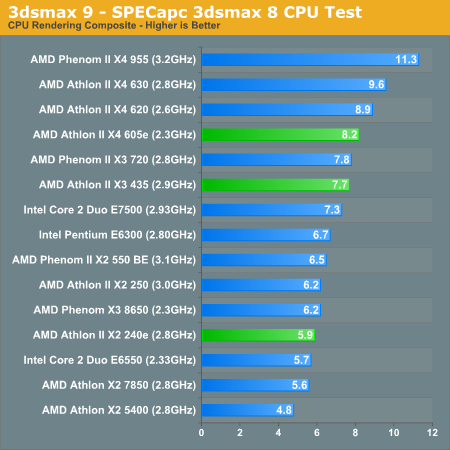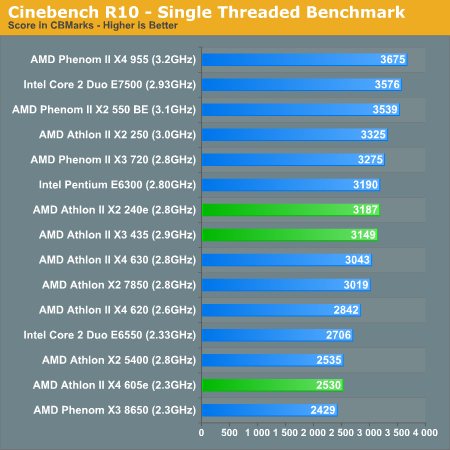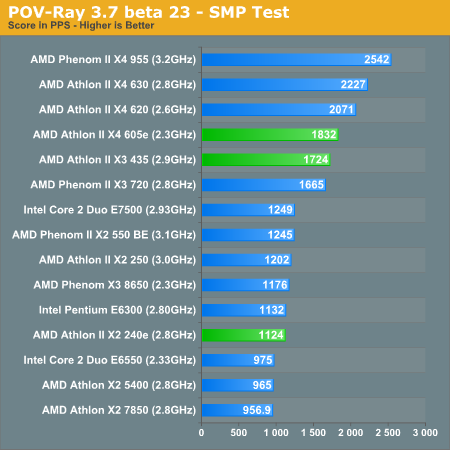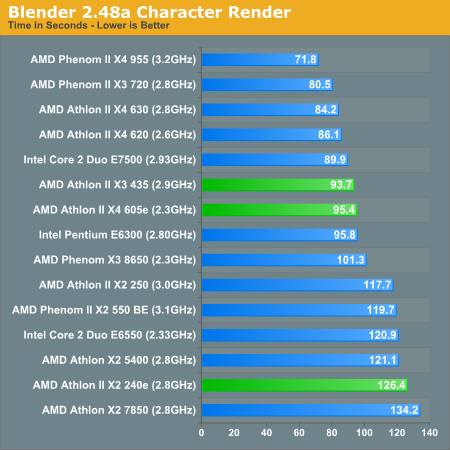AMD's Athlon II X3 435 & New Energy Efficient CPUs: Killing Intel Below $90
by Anand Lal Shimpi on October 20, 2009 12:00 AM EST- Posted in
- CPUs
3dsmax 9 - SPECapc 3dsmax CPU Rendering Test
Today's desktop processors are more than fast enough to do professional level 3D rendering at home. To look at performance under 3dsmax we ran the SPECapc 3dsmax 8 benchmark (only the CPU rendering tests) under 3dsmax 9 SP1. The results reported are the rendering composite scores:

Compared to the Intel dual-core options, the Athlon II X3 435 is a definite winner here. It's got the core count and clock speed to beat the old Penryn derivatives. Its biggest competition comes from its own family, the Athlon II X4 620 is the better buy here.
Cinebench R10
Created by the Cinema 4D folks we have Cinebench, a popular 3D rendering benchmark that gives us both single and multi-threaded 3D rendering results.

As I've been mentioning this entire time, the Athlon II X3 435 doesn't really sacrifice clock speed in its three-core configuration. At 2.9GHz even its single threaded performance is comparable to the Pentium E6300. Run a multithreaded app however and the performance goes from parity to leading:

POV-Ray 3.73 beta 23 Ray Tracing Performance
POV-Ray is a popular, open-source raytracing application that also doubles as a great tool to measure CPU floating point performance.
I ran the SMP benchmark in beta 23 of POV-Ray 3.73. The numbers reported are the final score in pixels per second.

The POV-Ray results echo what we've been seeing thus far, vs. Intel there's no contest - the 435 is the better value. Compared to the quad-core Athlon IIs however, the 435 isn't very good.
Blender 2.48a
Blender is an open source 3D modeling application. Our benchmark here simply times how long it takes to render a character that comes with the application.











177 Comments
View All Comments
maddoctor - Tuesday, October 20, 2009 - link
Currently, Intel does not need any competitor. Intel will crush them as soon as possible with prices cutting. This is their own fault, why they are not so competitive in performance and can not wins the benchmarkfsdetained - Wednesday, October 21, 2009 - link
Because they've done this so well with AMD for the last 20+ years... great logic little boy...santiago321 - Tuesday, October 20, 2009 - link
I am sure this joker has no idea about computers. If only designing GPU chips and killing competition was so simple.Tell you what, consider these two facts;
1. Intel has been trying to kill AMD for last 40 years and still trying
2. It took intel 5 years to add Northbridge in the die after amd did that in 2004.
Tech forums are no paradise for jokers. Go home and sleep well
coldpower27 - Friday, October 30, 2009 - link
1. Intel isn't trying to kill AMD, they are trying to shackle AMD into the budget range and keep them there, AMD sole purpose is to remain as a second supplier and to give the appearance of competition, so for Intel AMD serves a purpose.2. Intel didn't care about having a memory controller on their processors as they were already outperforming AMD's offerings without it. It isn't the be all and end all to performance and also comes with disadvantages as well. Core 2 outperformed Athlon 64's of the time, and were even to equivalently clocked 45nm Phenoms, 65nm AMD had it's own share of issues.
maddoctor - Tuesday, October 20, 2009 - link
What Intel never trying to kill AMD. This is only AMDiot assumption. Ask Anand, he will never agree with you AMDiot. This is the nature of capitalism. Money and product competitiveness are the facts that you can not denied.fsdetained - Wednesday, October 21, 2009 - link
Shitty pun, knock it off. Intel has tried to crush AMD since 1986. Where have you been? Oh, right, you probably weren't even born when the 8080 and 8086 processors came out for the IBM PC or even when the AM286 came out.Money, product, and competitiveness are not facts they are words you just threw out to sound like you know something. You have no clue about business, go back to your 6th grade classes.
yuhong - Tuesday, October 20, 2009 - link
"2. It took intel 5 years to add Northbridge in the die after amd did that in 2004. "Do you mean memory controller? But, BTW, Transmeta was able to put northbridge into the die back in 1999.
AnnihilatorX - Tuesday, October 20, 2009 - link
My sacarsm meter dial has turned through 3 circles and landed the negative spot.StevoLincolnite - Tuesday, October 20, 2009 - link
There is so much wrong with your post it's not funny, but I'll point some out.1) We have no idea how Larrabee will perform.
2) nVidia ATI/AMD are not going anywhere soon.
3) Intel got beaten by ATI and nVidia in the Graphics card market before when Intel released the Intel i740i AGP graphics card.
4) With Intels history of poor driver support for there Graphics solutions, I don't have much faith in Larrabee being different, I hope I'm wrong though, the added competition would be awesome.
5) If Intel owns the Chipset/CPU/Graphics markets 100% that would be -bad- no competition to keep prices low, remember when a decent computer would cost over 3 thousand bucks?
6) Both ATI and nVidia have had YEARS of experience in the Graphics industry, they will not let a new player into that market without a fight.
7) I would -not- be happy if we lost any extra company's especially AMD and nVidia, it would be all-round bad for everyone, I wouldn't have been able to build a stupidly cheap Quad-Core system (Athlon 2 x4 620) if it weren't for AMD.
pinguin - Tuesday, October 20, 2009 - link
>>remember when a decent computer would cost over 3 thousand bucks?I wouldn't mind paying $3000 for a decent computer, but please remember that even an undecent one would have set you back $1500 back then, while nowadays you can buy a $500 AMD rig